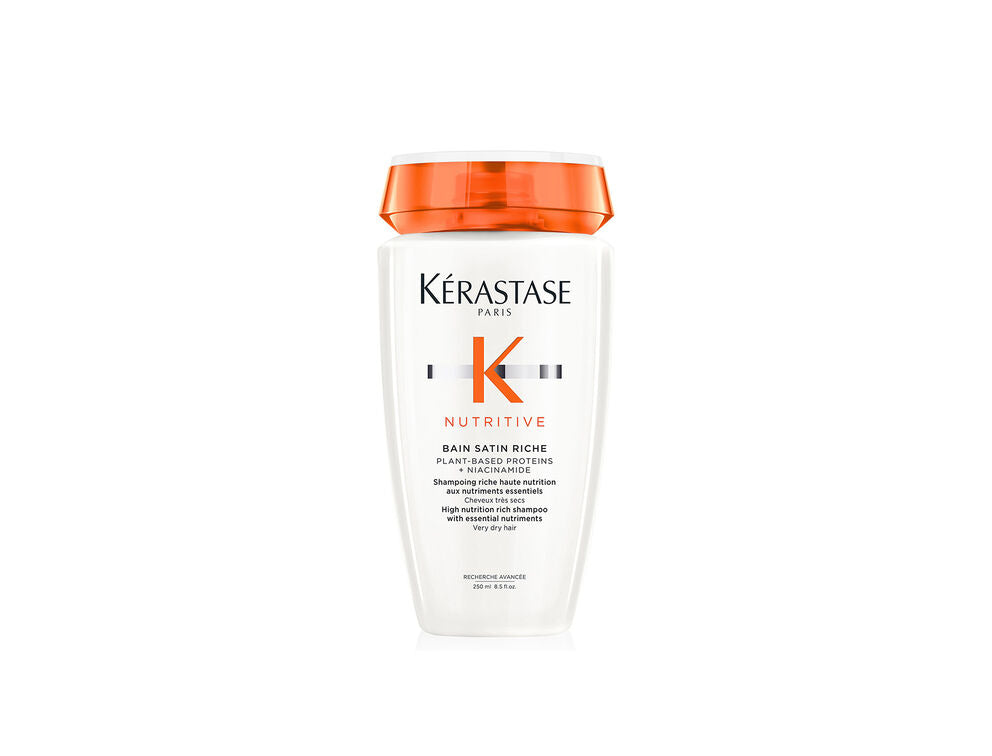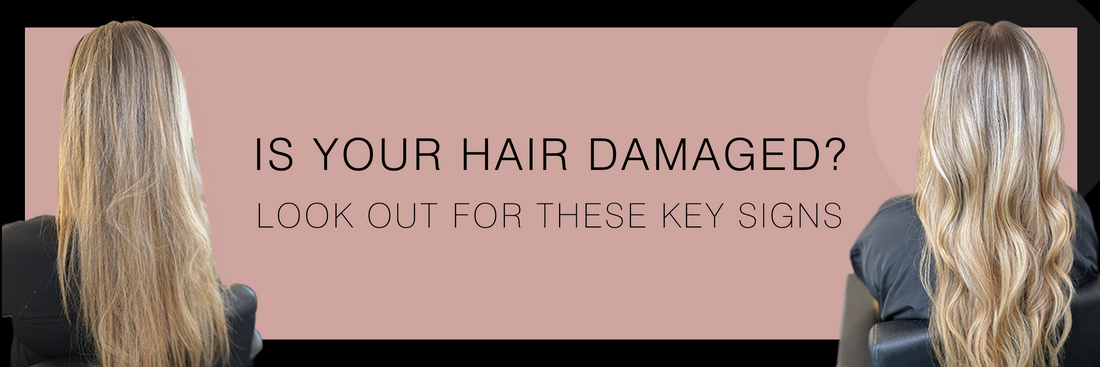Are you asking, ‘what does damaged hair look like’ and are struggling to find one exact answer? Well, we’re here to tell you, there isn’t just one…
There are several signs which tell hair is damaged, and even more reasons as to why. From excess hair fall due to breakage, to dull, lifeless locks – the fact is, we do something to damage our hair every single day. This includes heat styling, exposure to the elements, aggressive brushing, undergoing chemical treatments… the list goes on. So, what can you do?
We’re here to tell you what key signs to look out for as well as what steps you can take to prevent further damage and achieve luscious, healthy hair.
SIGN 1: DRY, BRITTLE HAIR
Q. Does your hair look and feel dry and brittle?
One of the first signs of damaged hair is that it usually feels dry and brittle and is lacking a healthy shine. This is because the hair lacks moisture and once it becomes brittle, this can lead to dullness, split ends, and breakage. Your strands can dry out for many reasons – heat damage, colour damage, or even just genetics – which is why it’s important to keep hair hydrated as much as possible.
A. How to treat dry, brittle hair
Thankfully, there are many things you can do to keep hair nourished and bring back that healthy, glowing shine. Firstly, we recommend vitamin-packed, nourishing shampoos and conditioners. You’ll want a shampoo which thoroughly cleanses the hair without removing its natural oils.
After you’ve washed your hair, make sure you’re squeezing out excess water before applying your conditioner as you may dilute its benefits. Your hair acts like a sponge where if it contains too much water, it has no room to soak up any more moisture. Gently squeeze out as much water as you can and if possible, gently towel-dry your ends before applying conditioner. For those with severely dry and brittle hair, leave the conditioner to soak into the hair for a while before washing away for maximum nourishment.
There are many brands which specialise in repair and hydration - Kérastase, Wella Professionals, and Moroccanoil being just a few that we highly recommend. You can shop their ranges online now or if you’re still not sure which products are right for you, head into your nearest salon to speak with our stylists. They can assess your hair and recommend the best range for your hair type and concerns.
SIGN 2: BREAKAGE AND SHEDDING
Q. Is your hair breaking and shedding excessively?
Have you noticed your strands snapping off and your split ends are worse than usual? Are you losing more hair than you think you should? Now split ends are completely normal, especially when you’re due for a trim, however if you’re experiencing a high volume of snapping then this is not a good sign.
This can happen through excessive heat styling or bleach application. Whilst it’s completely safe to use the two, it’s important that proper care is taken to ensure hair is protected. Although you can’t reverse breakage, there are things you can do to shield sensitised strands from further stress.
A. How to treat broken hair and split ends
You’ll need to work on building up your hairs strength and resilience again which can be done through the right products and techniques. We recommend investing in strengthening shampoos and conditioners – particularly ranges which help to rebuild bonds and repair the hair from within. You’ll also want to be applying a weekly conditioning mask as this will help nourish strands and make them more resistant to wear and tear.
As for split ends, you can seal them with an oil to temporarily smooth them down, however your best option is to get a cut. We recommend regular trims every four to six weeks, even if you’re only taking a smidge off to maintain longer hair. This will promote healthy hair growth and reduce frizz, dryness, and breakage.
Shop online, speak to our experts for their top recommendations, or book yourself in now for a nourishing treatment and cut and treat your hair to the care it deserves.
SIGN 3: TANGLES AND KNOTS
Q. Does your hair get tangled easily?
Tangles happen and a few knots is perfectly normal, especially after washing your hair. However, you shouldn’t be spending more than five minutes teasing them out. If you are and it’s becoming a problem, then this is likely a sign that your hair needs more nourishment. Dry, frizzy, or thin hair is prone to tangling, which indicates damage. Therefore, you should take care when detangling to prevent breakage. Taking a gentle approach is key to working out those knots and achieving silky-smooth hair.
A. How to effectively detangle hair to prevent breakage
When it’s time to wash your hair, we recommend using a conditioner or hair mask to detangle your hair. Not only will this add moisture, but it will help to soften the knots and allow you to easily work through them section by section. If you have curly or coily hair, you’ll want to apply this before shampooing and work through with your fingertips. For those with straight or slightly wavy hair, you can apply this after shampooing and work through with either your fingertips or a wide tooth comb.
When detangling your knots, make sure you’re not dragging your comb or brush from the root to the tip! This is what can cause extra shredding and breakage. Instead, work in sections and start at the tips and gently work your way up, patiently teasing out any knots as you go. Keep doing this until all the hair is smooth and tangle-free.
SIGN 4: DULL, BRASSY HAIR COLOUR
Q. Does your hair colour look dull and brassy?
When hair lacks moisture and essential nutrients, it can lose its shine and look rather dull. Whilst it could just mean that your colour is fading and needs a top-up, it could also potentially indicate damage. Faded, dull colour could also mean that your locks have been exposed to excessive sunlight or heat. Your hair can be brought back to life with an in-salon glazing and glossing service, however it will be important to upgrade your haircare routine so that you can keep your colour vibrant in between appointments.
A. How to treat dull, brassy hair
If you’re wanting to top-up your colour in salon without any damage whatsoever, then we recommend Wella Professionals Shinefinity Colour Glaze. It quite literally does zero damage and veils your strands in a silky shine with sheer, translucent colour. Our stylists can apply a clear glaze which works like a glossy topcoat, or if you want something more subtle and soft, they can dilute the shades further. You can book a free consultation with our experts, and they will be able to assess your current hairs condition and recommend the healthiest route for your strands.
To keep your hair looking vibrant and healthy in between salon visits, we recommend adding oils and shine sprays into your haircare routine. Hair products infused with oils provide a unique radiance, effectively replenishing moisture to parched strands for immediate shine and a long-term health boost. Shine sprays may be overlooked, but don’t underestimate their ability to really finesse a look. A shine spray will help to add a glossy shine without weighing down your strands.
Shop online or ask our experts for their top recommendations on your next visit.
SIGN 5: PRODUCTS AREN’T WORKING FOR YOU
Q. Have you noticed products aren’t making a difference to your hair?
If you’ve been trying all kinds of products and they’re just not doing what they say on the label, then you may be dealing with highly porous hair. Extreme damage can cause tears and gaps in the hair cuticle, which causes strands to become porous. These gaps and tears allow moisture to get in, however they also enable a timely escape – meaning any beneficial nutrients and proteins from your products will be lost. So, if your hair is not responding to hydrating products, don’t worry. There are a few minor changes you can make to ensure you’re locking in nourishment and preventing further damage.
A. How to treat highly porous hair
For those with colour-treated hair, products which are specifically formulated to treat coloured hair will be essential. This is because porous strands not only allow moisture to escape but also colour pigment. You’ll want a range that is packed with antioxidants to lock in your shade and protect it from fading.
You’ll also want to reach for oil- and cream-based conditioners. Products enriched with oils and creams offer substantial benefits by effectively sealing the hair cuticle, thereby enhancing the hair’s capacity to retain moisture. We recommend massaging any hair masks and conditioners into the mid-lengths and ends of clean, towel-dried hair. If your hair is extremely porous, leave on for a long time to allow it to soak up all the renourishing and revitalising ingredients. We’d then recommend opting for a leave-in treatment as this is light on the hair and will work its magic throughout the day.
Shop online now or speak to our experts. You can book a free consultation where your stylist can assess your hair and recommend the best tips, tricks, and products to treat your hair concerns.



